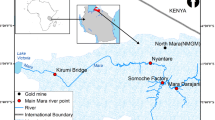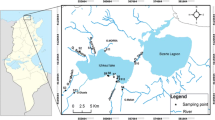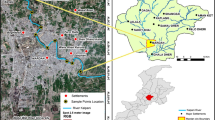Abstract
In the present study, an attempt was made to characterise bed sediments with respect to a river system, wherein sediment samples collected from May 2018 to June 2019 were subjected to bulk digestion and chemical partitioning. The concentrations of metals (Mn, Cu, Zn, Fe, Pb, Co, Cd) bound to five sedimentary phases or fractions were estimated using atomic absorption spectroscopy. On the basis of the five phases, the anthropogenic portion was estimated and are as follows: Mn (63%) > Zn (50%) > Cu (49%) > Cd (46%) > Fe (45%) > Pb (36%) > Co (34%). Then, anthropogenic contamination, as well as the ecological risk, was calculated using pollution load index (PLI), geoaccumulation index (Igeo), enrichment factor (EF), pollution index (IPOLL), potential risk of individual metal (Er) and potential ecological risk (PERI). Igeo and PLI show a continuous anthropogenic impact on the sediments in the post-monsoon months. IPOLL shows Mn falls in the ‘Moderately contaminate’ category, Cu and Zn falls in the ‘Uncontaminated to moderately contaminate’ category and rest falls in the ‘uncontaminated category’. From EF, Zn (7.98), Cd (6.40) and Pb (5.08) are significantly enriched in the river sediments indicating the source of metal as anthropogenic in origin. Er value of Cd in September is greater than 80, indicating ‘considerable ecological risk’. PERI value has the maximum for Cd (126.92), which belongs to the category 'Low ecological risk'. Even though PERI indicates 'low ecological risk' to the sediment contamination, continuous monitoring and management are needed in rivers to avoid significant pollution from domestic, commercial activities, agriculture and industrial activities as EF values are high for Zn, Cd, and Pb, which shows anthropogenic contamination.






Similar content being viewed by others
Availability of data and materials
The datasets used and/or analysed during the current research are available in a manuscript.
References
Alonso DL, Pérez R, Okio CKYA, Castillo E (2020) Assessment of mining activity on arsenic contamination in surface water and sediments in southwestern area of Santurbán paramo, Colombia. J Environ Manag. https://doi.org/10.1016/j.jenvman.2020.110478
Baird R, Eaton A, Rice E (eds) (2017) Standard methods for the examination of water and wastewater. American Public Health Association, American Water Works Association, Denver
Berrow ML (1986) Chemical methods for assessing bio-available metals in sludges and soils. Agric Wastes 15:314–316. https://doi.org/10.1016/0141-4607(86)90029-6
Bodek I, Lyman WJ, Reehl WF, Rosenblatt DH (1988) SETAC Special Publications Series Environmental Inorganic Chemistry. Properties, Processes, and Estimation Methods
Bora M, Goswami DC (2014) Study for restoration using field survey and geoinformatics of the Kolong River, Assam, India. J Environ Res Dev 8:997–1004
Boszke L, Kowalski A, Astel A et al (2008) Mercury mobility and bioavailability in soil from contaminated area. Environ Geol 55:1075–1087. https://doi.org/10.1007/s00254-007-1056-4
Bouzekri S, El Fadili H, El Hachimi ML et al (2020) Assessment of trace metals contamination in sediment and surface water of quarry lakes from the abandoned Pb mine Zaida, High Moulouya-Morocco. Environ Dev Sustain 22:7013–7031. https://doi.org/10.1007/s10668-019-00525-y
Chapman D (1996) Water quality assessments—a guide to use of biota, sediments and water in environmental monitoring —second edition edited by, P 626
Chen M, Ma LQ, Harris WG (1999) Baseline concentrations of 15 trace elements in Florida surface soils. J Environ Qual 28:1173–1181. https://doi.org/10.2134/jeq1999.00472425002800040018x
Cheng WH, Yap CK (2015) Potential human health risks from toxic metals via mangrove snail consumption and their ecological risk assessments in the habitat sediment from Peninsular Malaysia. Chemosphere 135:156–165. https://doi.org/10.1016/j.chemosphere.2015.04.013
Choudhury TR, Acter T, Uddin N et al (2021) Heavy metals contamination of river water and sediments in the mangrove forest ecosystems in Bangladesh: A consequence of oil spill incident. Environ Nanotechnol Monit Manag. https://doi.org/10.1016/j.enmm.2021.100484
CPCB (2015) River stretches for restoration of water quality. A Ministry of Environment, Forest and Climate change report
CPCB (2008) Annual Water Quality Statistics of India, from 1994 to 2008, Central Pollution Control Board, Government of India. Monitoring of Indian National Aquatic Resources Series: MINARS/7/1991-92, to MINARS/28/2007-2008. http://www.envfor.nic.in/nrcd
de Groot AJ (2018) Metals and sediments: a global perspective. In: Metal contaminated aquatic sediments, Routledge, pp 1–20
Derakhshannia M, Dalvand S, Asakereh B, Ostad-Ali-Askari K (2020) Corrosion and deposition in Karoon River, Iran, based on hydrometric stations. Int J Hydrol Sci Technol 10:334–345. https://doi.org/10.1504/IJHST.2020.108264
Dhanakumar S, Murthy KR, Solaraj G, Mohanraj R (2013) Heavy-metal fractionation in surface sediments of the Cauvery River estuarine region, southeastern coast of India. Arch Environ Contam Toxicol 65:14–23. https://doi.org/10.1007/s00244-013-9886-4
Duncan AE, de Vries N, Nyarko KB (2018) Assessment of heavy metal pollution in the sediments of the River Pra and its tributaries. Water Air Soil Pollut. https://doi.org/10.1007/s11270-018-3899-6
Elias HMS, Rahman SA et al (2012) Assessment of sediment quality collected from Tunku Abdul Rahman Park, Sabah. J Sains Nukl Malaysia 24:59–70
EPA (2005) Ecological soil screening level for iron interim final. US Environ Prot Agency—Off Solid Waste Emerg 211
Förstner U (1982) Accumulative phases for heavy metals in limnic sediments. Hydrobiologia 91–92:269–284. https://doi.org/10.1007/bf00940118
Förstner U, Salomons W (1980) Trace metal analysis on polluted sediments. Environ Technol Lett 1:494. https://doi.org/10.1080/09593338009384006
Gibbs RJ (1973) Mechanisms of trace metal transport in rivers. Science (80-) 180:71–73. https://doi.org/10.1126/science.180.4081.71
Golian M, Katibeh H, Singh VP et al (2020) Prediction of tunnelling impact on flow rates of adjacent extraction water wells. Q J Eng Geol Hydrogeol 53:236–251. https://doi.org/10.1144/qjegh2019-055
Hakanson L (1980) An ecological risk index for aquatic pollution control. A sedimentological approach. Water Res 14:975–1001. https://doi.org/10.1016/0043-1354(80)90143-8
Harikumar PS, Nasir UP, Mujeebu Rahman MP (2009) Distribution of heavy metals in the core sediments of a tropical wetland system. Int J Environ Sci Technol 6:225–232
Hazarika S, Bhuyan B (2013) Fluoride, arsenic and iron content of groundwater around six selected tea gardens of Lakhimpur District, Assam, India. Arch Appl Sci Res 5:57–61
Hseu ZY, Chen ZS, Tsai CC, Tsui CC (2002) Baseline concentrations of ten metals in the freshwater sediments of a watershed in Taiwan. J Environ Sci Health Part A Toxic Hazard Subst Environ Eng 37:1633–1647. https://doi.org/10.1081/ESE-120015426
Jorfi S, Maleki R, Jaafarzadeh N, Ahmadi M (2017) Pollution load index for heavy metals in Mian-Ab plain soil, Khuzestan, Iran. Data Brief 15:584–590. https://doi.org/10.1016/j.dib.2017.10.017
Karbassi AR, Monavari SM, Nabi Bidhendi GR et al (2008) Metal pollution assessment of sediment and water in the Shur River. Environ Monit Assess 147:107–116. https://doi.org/10.1007/s10661-007-0102-8
Karbassi AR, Torabi F, Ghazban F, Ardestani M (2011) Association of trace metals with various sedimentary phases in dam reservoirs. Int J Environ Sci Technol 8:841–852. https://doi.org/10.1007/BF03326267
Kaushik A, Kansal A, Santosh K et al (2009) Heavy metal contamination of river Yamuna, Haryana, India: assessment by metal enrichment factor of the sediments. J Hazard Mater 164:265–270. https://doi.org/10.1016/j.jhazmat.2008.08.031
Kersten M, Forstner U (1986) Chemical fractionation of heavy metals in anoxic estuarine and coastal sediments. Water Sci Technol 18:121–130. https://doi.org/10.2166/wst.1986.0187
Kittrick JA (1971) Handbook of geochemistry. Soil Sci Soc Am J 35:viii. https://doi.org/10.2136/sssaj1971.03615995003500030012x
Kumar S, Islam ARMT, Islam HMT et al (2021) Water resources pollution associated with risks of heavy metals from Vatukoula Goldmine region, Fiji. J Environ Manag. https://doi.org/10.1016/j.jenvman.2021.112868
Li H, Shi A, Li M, Zhang X (2013) Effect of pH, temperature, dissolved oxygen, and flow rate of overlying water on heavy metals release from storm sewer sediments. J Chem. https://doi.org/10.1155/2013/434012
Lim WY, Aris AZ, Tengku Ismail TH (2013) Spatial geochemical distribution and sources of heavy metals in the sediment of Langat River, Western Peninsular Malaysia. Environ Forensics 14:133–145. https://doi.org/10.1080/15275922.2013.781078
Mahurpawar M (2015) Effects of heavy metals on human health effects of heavy metals on human health. Int J Res Granthaalayah 3:1–7. https://doi.org/10.29121/granthaalayah.v3.i9se.2015.3282
McLusky DS, Elliott M (2004) The estuarine ecosystem: ecology, threats, and management. CEUR Workshop Proc. https://doi.org/10.1017/CBO9781107415324.004
Milliman JD, Meade RH (1983) World-wide delivery of sediment to the oceans. J Geol 91:1–21. https://doi.org/10.1086/628741
Müller G (1969) Index of geoaccumulation in sediments of the Rhine River. Geol J 2:108–118
Newman CP, Paschke SS, Keith G (2021) Natural and anthropogenic geochemical tracers to investigate residence times and groundwater–surface-water interactions in an urban alluvial aquifer. Water (switzerland). https://doi.org/10.3390/w13060871
Ogamba EN, Charles EE, Izah SC (2021) Distributions, pollution evaluation and health risk of selected heavy metal in surface water of Taylor creek, Bayelsa State, Nigeria. Toxicol Environ Health Sci 13:109–121. https://doi.org/10.1007/s13530-020-00076-0
Omwene PI, Öncel MS, Çelen M, Kobya M (2019) Influence of arsenic and boron on the water quality index in mining stressed catchments of Emet and Orhaneli streams (Turkey). Environ Monit Assess. https://doi.org/10.1007/s10661-019-7337-z
Ostad-Ali-Askari K, Shayannejad M (2021) Quantity and quality modelling of groundwater to manage water resources in Isfahan-Borkhar Aquifer. Environ Dev Sustain. https://doi.org/10.1007/s10668-021-01323-1
Ostad-Ali-Askari K, Shayannejad M, Ghorbanizadeh-Kharazi H (2017) Artificial neural network for modeling nitrate pollution of groundwater in marginal area of Zayandeh-rood River, Isfahan, Iran. KSCE J Civ Eng 21:134–140. https://doi.org/10.1007/s12205-016-0572-8
Ostad-Ali-Askari K, Ghorbanizadeh Kharazi H, Shayannejad M, Zareian MJ (2019) Effect of management strategies on reducing negative impacts of climate change on water resources of the Isfahan-Borkhar aquifer using MODFLOW. River Res Appl 35:611–631. https://doi.org/10.1002/rra.3463
Ostad-Ali-Askari K, Ghorbanizadeh Kharazi H, Shayannejad M, Zareian MJ (2020) Effect of climate change on precipitation patterns in an arid region using GCM models: case study of Isfahan-Borkhar Plain. Nat Hazards Rev 21:04020006. https://doi.org/10.1061/(asce)nh.1527-6996.0000367
Parmar S, Sharma VK, Singh V, Kharwar RN (2021) Seasonal variation of potentially toxic metal contamination in Yamuna riverine ecosystem, Delhi, India. Environ Monit Assess. https://doi.org/10.1007/s10661-021-08987-2
Qingjie G, Jun D, Yunchuan X et al (2008) Calculating pollution indices by heavy metals in ecological geochemistry assessment and a case study in parks of Beijing. J China Univ Geosci 19:230–241. https://doi.org/10.1016/S1002-0705(08)60042-4
Roudposhti GM, Karbassi A, Baghvand A (2016) A pollution index for agricultural soils. Arch Agron Soil Sci 62:1411–1424. https://doi.org/10.1080/03650340.2016.1154542
Sakan SM, Dordević DS, Manojlović DD, Predrag PS (2009) Assessment of heavy metal pollutants accumulation in the Tisza river sediments. J Environ Manag 90:3382–3390. https://doi.org/10.1016/j.jenvman.2009.05.013
Salomons W, Forstner U (1984) Metals in the hydrocycle. Met Hydrocycle. https://doi.org/10.2307/2403266
Santana CS, Montalván Olivares DM, Silva VHC et al (2020) Assessment of water resources pollution associated with mining activity in a semi-arid region. J Environ Manag 273:111148. https://doi.org/10.1016/j.jenvman.2020.111148
Sarker KK, Bristy MS, Alam N et al (2020) Ecological risk and source apportionment of heavy metals in surface water and sediments on Saint Martin’s Island in the Bay of Bengal. Environ Sci Pollut Res 27:31827–31840. https://doi.org/10.1007/s11356-020-09384-x
Schwantes D, Gonçalves Junior AC, Manfrin J et al (2021) Distribution of heavy metals in sediments and their bioaccumulation on benthic macroinvertebrates in a tropical Brazilian watershed. Ecol Eng. https://doi.org/10.1016/j.ecoleng.2021.106194
Siddiquee NA, Parween S, Quddus MMA, Barua P (2014) Heavy metal pollution in sediments at ship breaking area of Bangladesh. In: Coastal environments: focus on Asian regions, pp 78–87
Singh M, Müller G, Singh IB (2002) Heavy metals in freshly deposited stream sediments of rivers associated with urbanisation of the Ganga Plain, India. Water Air Soil Pollut 141:35–54
Sundaray SK, Nayak BB, Lin S, Bhatta D (2011) Geochemical speciation and risk assessment of heavy metals in the river estuarine sediments—a case study: Mahanadi basin, India. J Hazard Mater 186:1837–1846. https://doi.org/10.1016/j.jhazmat.2010.12.081
Talebmorad H, Abedi-Koupai J, Eslamian S et al (2021) Evaluation of the impact of climate change on reference crop evapotranspiration in Hamedan-Bahar plain. Int J Hydrol Sci Technol 11:333–347. https://doi.org/10.1504/IJHST.2021.114554
Teodorof L, Burada A, Despina C et al (2020) Sediments quality assessment in terms of single and integrated indices from Romanian MONITOX network (2019–2020). Ann “Dunarea Jos” Univ Galati Fascicle II Math Phys Theor Mech 43:175–183. https://doi.org/10.35219/ann-ugal-math-phys-mec.2020.2.16
Tessier A, Campbell PGC, Bisson M (1979) Sequential extraction procedure for the seciation of particulate trace metals. Anal Chem 51:844–851. https://doi.org/10.1021/ac50043a017
The Council of the European Union (2010) Heavy metals and organic compounds from wastes used as organic fertilisers. Quality, pp 1–21
Thornton J, Steel A, Rast W (1992) Water quality assessments—a guide to use of biota, sediments and water in environmental monitoring. In: Water quality assessments—a guide to use of biota, sediments and water in environmental monitoring. pp 371–375
Tomlinson DL, Wilson JG, Harris CR, Jeffrey DW (1980) Problems in the assessment of heavy-metal levels in estuaries and the formation of a pollution index. Helgoländer Meeresuntersuchungen 33:566–575. https://doi.org/10.1007/BF02414780
USEPA (1997) Acid digestion of sediment, sludge, and soils. Method 3050B
USEPA O (2002) Risk assessment guidance
Vardhan KH, Kumar PS, Panda RC (2019) A review on heavy metal pollution, toxicity and remedial measures: Current trends and future perspectives. J Mol Liq 290:111197
WHO (2013) WHO Guidelines on Good Agricultural and Collection Practices (GACP)
Zhang Z, Juying L, Mamat Z (2016) Sources identification and pollution evaluation of heavy metals in the surface sediments of Bortala River, Northwest China. Ecotoxicol Environ Saf 126:94–101. https://doi.org/10.1016/J.ECOENV.2015.12.025
Funding
No particular grants from funding agencies were obtained for the study.
Author information
Authors and Affiliations
Contributions
APG and AK provided this concept, and APG and SD analysed the data and wrote the complete document, while the final version was read and accepted by AK.
Corresponding author
Ethics declarations
Conflict of interest
The authors note that they do not have any competing financial interests or personal relationships formed that could have influenced the work discussed in this paper.
Ethical approval
Not applicable.
Consent to Participate
For further clarification and information, I shall be free to contact any of the people involved in the research.
Consent to publish
Not applicable.
Additional information
Publisher's Note
Springer Nature remains neutral with regard to jurisdictional claims in published maps and institutional affiliations.
Rights and permissions
About this article
Cite this article
Goswami, A.P., Das, S. & Kalamdhad, A.S. Assessment of possible pollution risk using spatial distribution and temporal variation of heavy metals in river sediments. Environ Earth Sci 80, 677 (2021). https://doi.org/10.1007/s12665-021-09983-y
Received:
Accepted:
Published:
DOI: https://doi.org/10.1007/s12665-021-09983-y




